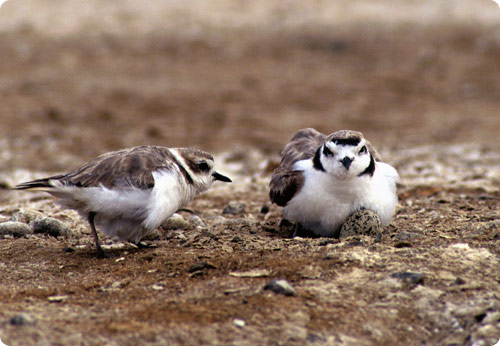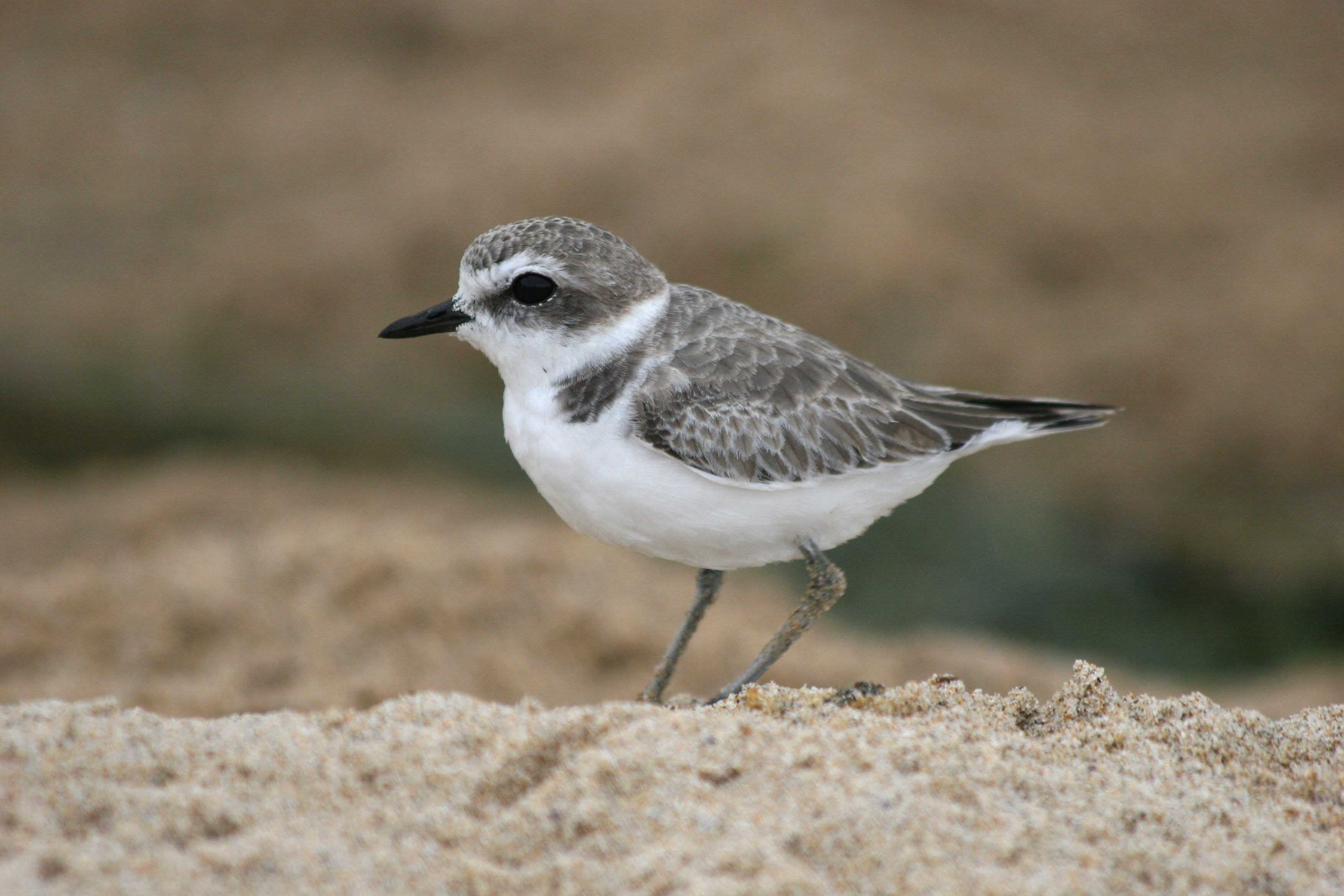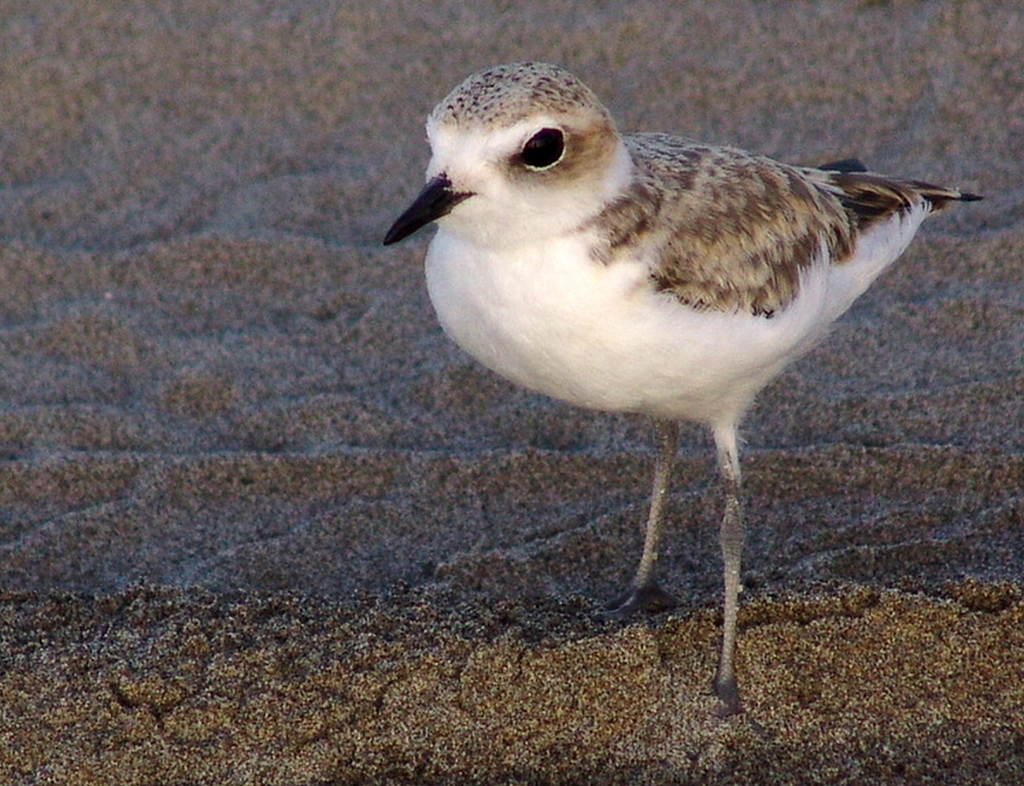
Charadrius alexandrinus
SUBFAMILY
Charadriinae
TAXONOMY
Charadrius alexandrinus Linnaeus, 1758. At least six subspecies
are recognized.
OTHER COMMON NAMES
English: Kentish plover, sandplover; French: Gravelot а Collier
interrompu; German: Seeregenpfeifer; Spanish: Chorlitejo
Patinegro.
PHYSICAL CHARACTERISTICS
6–6.75 in (15–17 cm); 1–2 oz (28–57 g). Upperparts pale
brown, especially pale in North American population. Breast
band restricted to the lateral edges of the breast; white ring
around the neck. Crown may be rufous. In breeding males a
distinct, dark frontal bar marks the end of a white forehead
and a dark line extends from bill to ear. Bill is black, and legs
and feet are dark gray to black.
DISTRIBUTION
Breeds along the western U.S. coast from Washington to
lower California and intermittently along the Gulf Coast from
Marco Island, Florida, to the north coast of the Yucatan
Peninsula. Breeds inland in south central Oregon, Salton Sea
and eastern California, western and central Nebraska, northwestern
Utah, and southern Arizona. Also breeds in the West
Indies and on islands off the coast of Venezuela. Winters in
the Gulf drainage south to Yucatan and northern South
America and in the Pacific drainage from central California to
western Mexico. A resident population (C. a. occidentalis) is
found on the coast of Peru and Chile. C. a. alexandrinus
breeds in Eurasia from southern Sweden to the northern Sahara
to western India and the steppes of central Asia through
western China. Winters from the Mediterranean Basin south
to tropical Africa, Angola, and Sri Lanka. C. a. seebohmi is resident
in Sri Lanka. C. a. dealbatus breeds in eastern China and
Japan and winters from Japan to Taiwan and the Philippines
and from southeastern China to Indochina and the Greater
Sundas.
HABITAT
Prefers open coastal areas, including sand and shingle beaches,
estuaries, lagoons, and mudflats as well as inland along saline
lakes. May also be found along rivers and on sparsely vegetated
steppes. In North America it favors beaches and both coastal
and inland salt flats. Inland it is found along braided river
channels. Nests primarily on sandy coastal beaches, dunes,
spoil islands, and salt flats or inland near brackish or saline
wetlands. Several hundred birds nest and winter at agricultural
wastewater ponds in the San Joaquin Valley and at the Salton
Sea formed in southern California as a result of accidental
flooding in the early 1900s. Mostly coastal outside the breeding
season. Rare in freshwater habitats.
BEHAVIOR
Species includes both resident and migrant populations. Most
birds in flocks of up to 300 during winter, although some defend
winter territories. Small groups of birds may take off in
coordinated flights when disturbed. Both chicks and adults can
swim, and adults may lead chicks across ponds and rivers.
While territories are important sites for nesting and feeding,
some birds frequently forage communally at undefended
feeding areas. Feeding areas as much as 3.7 mi (6 km) from
the nest have been documented.
FEEDING ECOLOGY AND DIET
Runs, stops, looks, and pecks as is common in plovers, but also
probes at the bases of plants and runs into dense masses of flies
with bill open and snapping. May also charge after solitary insects.
Occasionally pats substrate with foot. Mostly gathers
food from sand surface both above and below mean high tide
mark. Inland, often forages in 0.39–0.79 in (1–2 cm) deep water
or on wet surfaces.
REPRODUCTIVE BIOLOGY
Frequently retain their mate for more than one year, and one
pair remained mated for at least six years, apparently as a result
of territorial fidelity. Rarely male may mate with two females
and alternate incubation at the two resulting nests. Birds often
show nest site fidelity. Nest is often located near an item such
as piece of driftwood or small clump of vegetation that distinguishes
an otherwise uniform landscape. Nests are formed by
scraping and lined by both sexes randomly picking up bits of
debris and tossing it over their shoulders and into the nest.
Lining eventually includes such items as pebbles, fish bones,
and arthropod skeletons. During copulation male grasps the female’s
neck and falls backward, pulling her with him. Clutch
size is usually three, but varies from 2–6.
Both sexes incubate, but at least in some localities the female
incubates more during the day and the male at night. Incubation
requires from 23–32 days. Young are precocial and
leave nest soon after hatching.
In western North America females desert broods soon after
hatching, mate with a different male, and initiate another nest.
This allows for the production of multiple broods. Males also
take a new mate and re-nest, in some cases as early as 10 days
before the current brood fledges. Birds may move several hundred
kilometers to re-nest. Females may mate with original
mate to produce a third brood. In some localities only one
brood is produced. Parental care includes leading chicks to
food, watching and warning of danger, and giving injuryfeigning
distractions.
Breeding territories may be small. In some localities average
distance between nests was 120 ft (36 m). Breeding typically
occurs during the first year.
CONSERVATION STATUS
North American Pacific and Gulf Coast populations are
shrinking, with current populations estimated at 21,000 individuals
in the United States. The Pacific Coast population is
listed as Threatened by the U.S. Fish and Wildlife Service.
HABITAT
loss and destruction is an important factor contributing
to population decline. Chief problems are increased recreational
use of beaches, regular raking to keep beaches attractive
to humans, and use of beach grass (Ammophila arenaria) to
stabilize beaches. Inland habitat has been lost as a result of human-
mediated changes such as dam construction and growth of
vegetation. Less important factors include pesticides, entanglement
in monofilament line, being run over and stepped on,
and shooting and trapping.
SIGNIFICANCE TO HUMANS
None known.
Photo Gallery of - Snowy plover




 Animalia Life
Animalia Life